This event was something of a ‘first’. I’ve made steady progress in writing comparative tastings for most of Virginia’s major varietals, and only occasionally felt the need to revisit a grape. Yet this didn’t stop me from doing my 3rd comparison of Petit Verdot; the most I’ve ever done with a single variety.
For those not familiar with Petit Verdot, the ‘little green’ (the English translation of ‘petit verdot’) is one of Virginia’s signature grapes. A high-acid variety, PV can retain that acidity despite Virginia’s hot summers. It’s also fairly weather resistant, making it popular for vineyard managers.
PV also provides color and tannin to blends. In many ways PV has become a blending replacement for Cab Sauv, which is a difficult grape for Virginia to grow. That the two most recent Virginia Governor’s Cup winning wines were PV-heavy isn’t a coincidence.
These traits have allowed PV to become the 3rd most planted grape in the state, widely used both as a stand-alone varietal and a blending partner. PV’s main drawback is its berries are small, so there’s not a lot of tonnage (as one would expect from a grape with the name ‘petit’ in it).

My first PV comparison only used PVs from Virginia’s 2017 vintage. The second was a multi-vintage (and multi-state) PV comparison. Arterra’s 2017 and DuCard’s 2017 PVs won each of their respective events, so I decided to move on to a 2019-vintage comparison.
Most wineries would agree that 2019 was a good to excellent vintage, particularly for reds. It was a hot summer so alcohol levels were slightly on the higher side, but it also delivered on ripeness.
Just as importantly, doing a horizontal tasting of 2019 vintage wines meant the only differences came from the vineyard and winemaker, which evened the playing field.
I can’t confirm that every bottle was 100% PV but I strongly suspect they were.
Tasting & Scoring Methodology
A group of friends & I blind tasted 9 wines in 3 flights. All the flights were bagged; even I didn’t know which-was-which, as I bagged them randomly.
We didn’t have a fancy scoring system. The goal was to pick a ‘favorite’ every round, as opposed to rating them and determining the one we thought was the ‘best’.
I will say this was one of the most even playing fields I’ve ever had. We had bottles from 9 exceptional wineries from an exceptional vintage. EVERY one of these wines were good-to-excellent.
Moreover, by the end of the night there was a lot of people who insisted their favorite wine of the night didn’t make it to the ‘finalist’ round. Although my selection process forced us to choose a ‘favorite’ every round, that’s not to say the final ones were “everybody’s” favorite. More than a few excellent bottles simply got out-voted by our group of 7.
The Contenders:
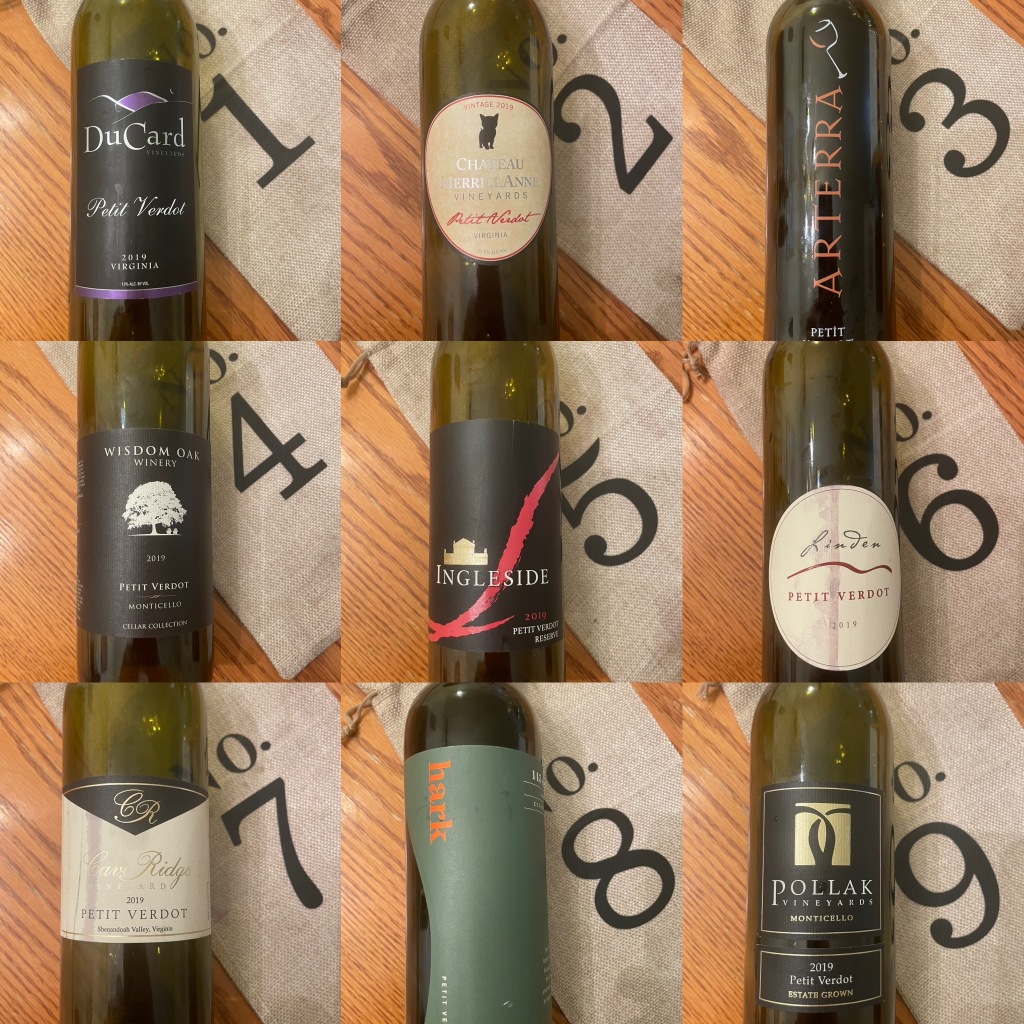
- DuCard Vineyards 2019 Petit Verdot (100%)
- Chateau MerrillAnne 2019 Petit Verdot (100%)
- Arterra Wine 2019 Petit Verdot (100%)
- Wisdom Oak Winery 2019 Petit Verdot (100%)
- Ingleside Vineyards 2019 Petit Verdot
- Linden Vineyards 2019 Petit Verdot (100%)
- Cave Ridge Vineyard 2019 Petit Verdot (100%)
- Hark Vineyards 2019 Petit Verdot (100%)
- Pollack Vineyards 2019 Petit Verdot
Round 1 / Flight #1:
- Bottle #1: DuCard Vineyards
- Bottle #2: Chateau MerrillAnne (Round winner)
- Bottle #3: Arterra Wine
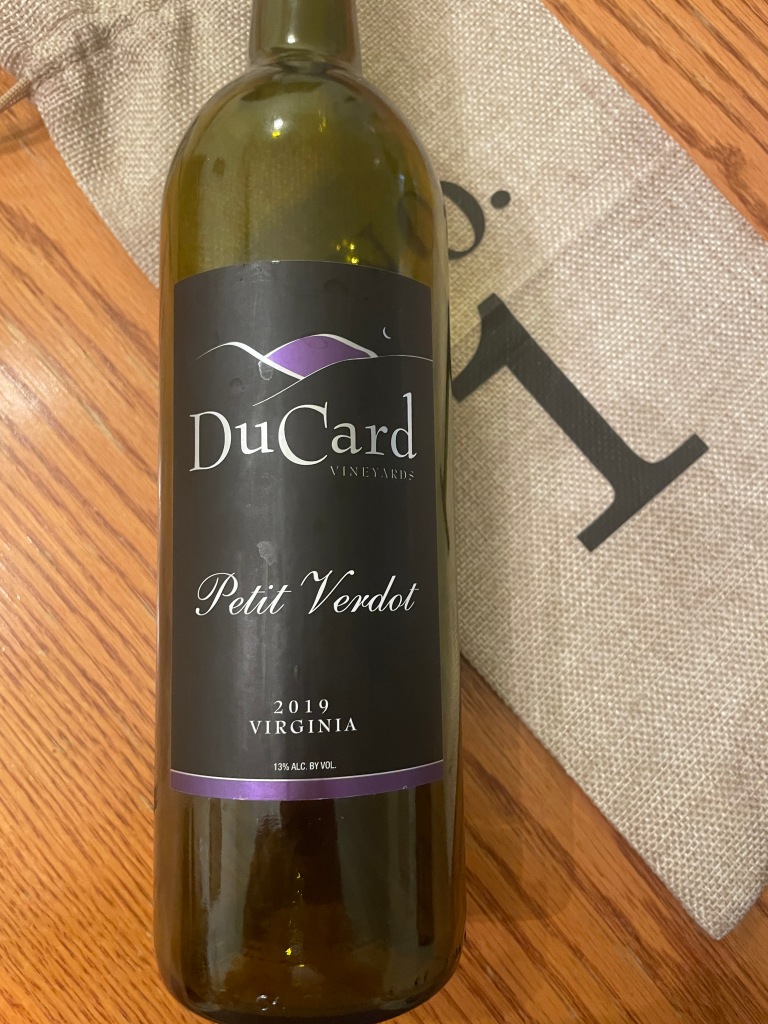

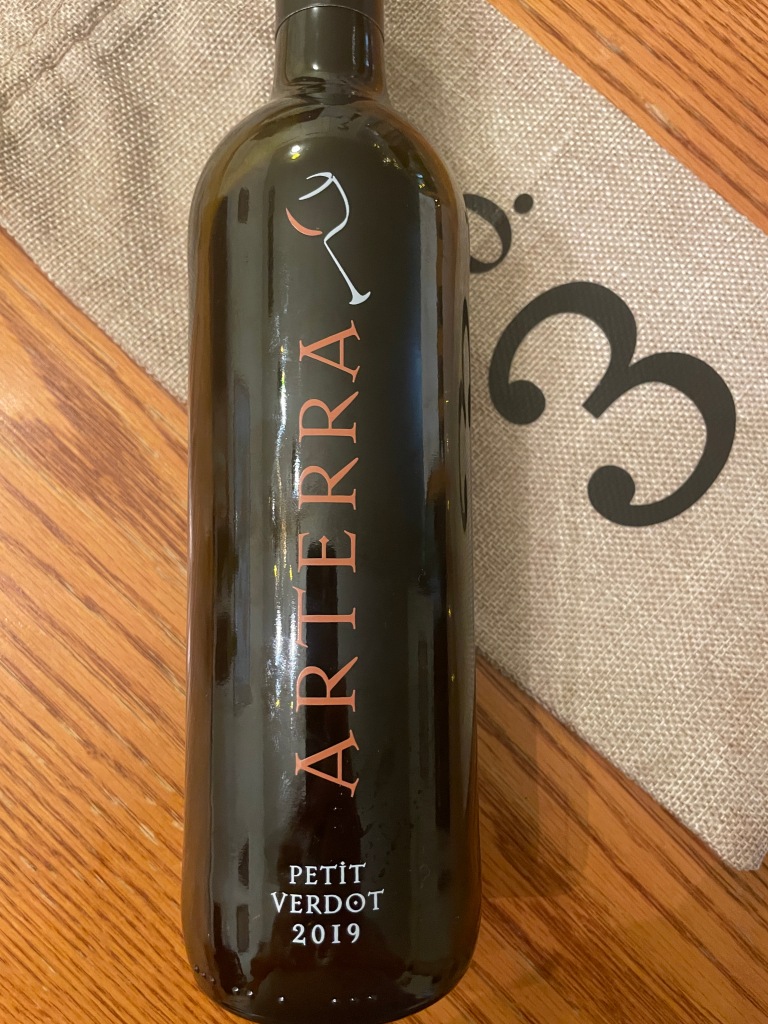
This arguably was my favorite round, and it demonstrated how hard it was for us to pick a ‘favorite’. I’m convinced #1/DuCard could easily have been the best of the day, but the randomness of these tastings put it against the wine that went on to win the event. Even so, I was tempted to give #1 a “Wild Card” advance.
In terms of coloration #2 was the lightest and #3 was the darkest. #1 and #2 opened up nicely as the round went on. None of them were overly expressive on the nose; the nose opened up a little but PV isn’t an overly aromatic variety.
We spent a lot of time on wine descriptors during this round, just go get people comfortable speaking their mind.
Bottle #1 DuCard Vineyards: Lots of tasting notes, if only because the group was opinionated, and this bottle was speaking to us.
On the nose I got lots of violet. On the palate the most popular descriptors were dark fruit (especially cherry or strawberry), pepper, spice notes, plus grippy tannin. Someone mentioned notes of cedar.
It was a very drinkable and balanced wine. #1 opened up nicely about halfway through and the fruit became more pronounced, which made it REALLY hard for me to not pick it as my round favorite.
Bottle #2 Chateau MerrillAnne: On the nose people mentioned notes of tobacco, blackberry or black fruit in general. On the palate, red fruit.
I also heard someone say it had a “Dr. Pepper” note to it. Another said there was some heat on the nose, plus maybe notes of mocha. Overall, it was a balanced, complex wine.
Bottle #3 Arterra Wine: We didn’t realize it at the time, but at 16.5% this was the highest alcohol wine of the day. That percentage gave #1 the perception of sweetness, despite zero RS. This would have rocked with a spicy dish though.
The color was especially dark. Of the trio, we felt it had the least amount of oak treatment. The group mentioned notes of black cherry, chocolate, or blueberry, plus tartness on the back end. My favorite descriptor was it was smokey, or even had a ‘old library’ note.
This soon became a contest between #1 and #2 for round favorite, and most voters only narrowly went with #2. The general consensus (but with two exceptions) is while people liked #3, the high alcohol made it a ‘one glass’ wine, while #1 and #2 were wines you could more easily enjoy.
Votes:
- Alex: 2/1/3. Mentioned the #1 (DuCard) reminded him of a Russian River Valley pinot.
- Ashley: 2/1/3.
- Brandon: 2/1/3. Felt #2 (Chateau MerrillAnne) was the most complex.
- Emily: 3/1/2. Felt #3 (Arterra) was ‘cozy’ and stood out, and especially liked the aroma.
- Frank: 2/1/3. Felt #2 was the most complex, reminded him of a cigar box.
- Isabel: 3/2/1
- Matt: 2/1/3. Was torn between the complexity of #2 or fruit-forward notes of #1, which once it opened up was very lovely.
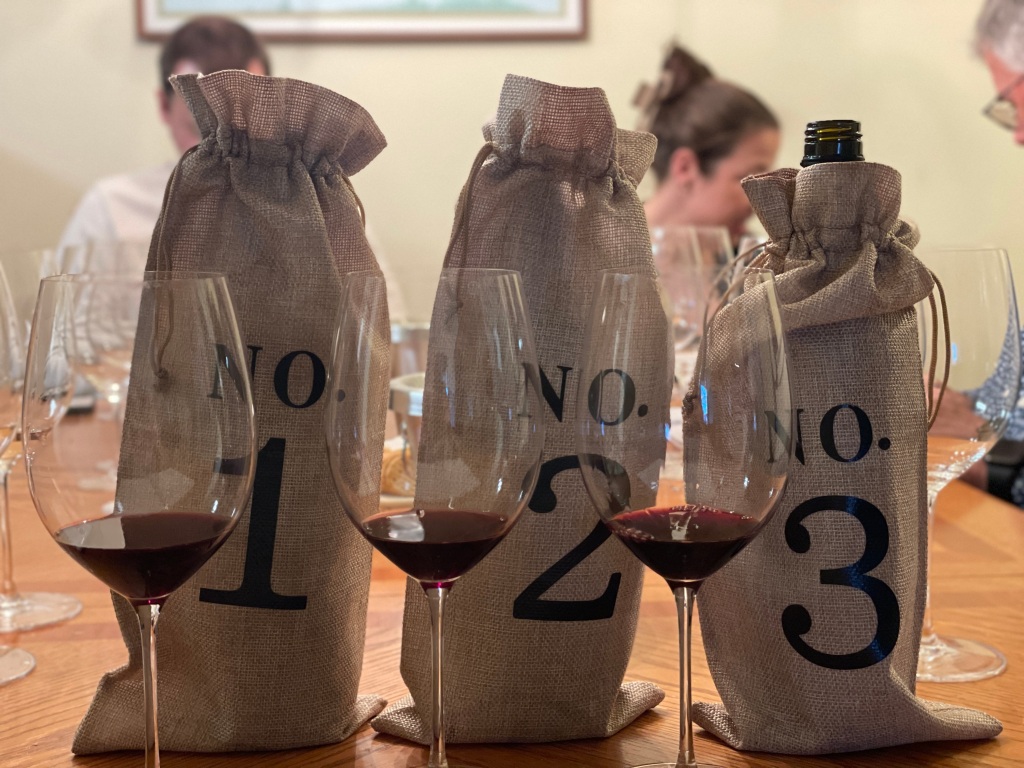
Round 1 / Flight #2:
- Bottle #4: Wisdom Oak Winery (Round winner)
- Bottle #5: Ingleside Vineyards
- Bottle #6: Linden Vineyards
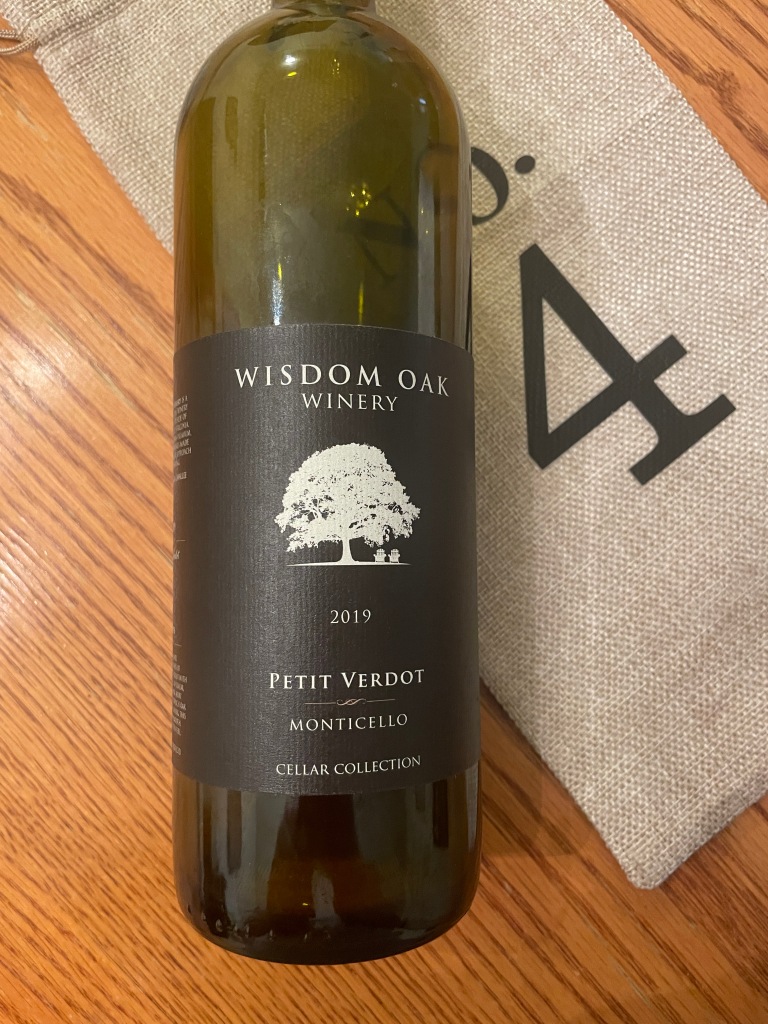
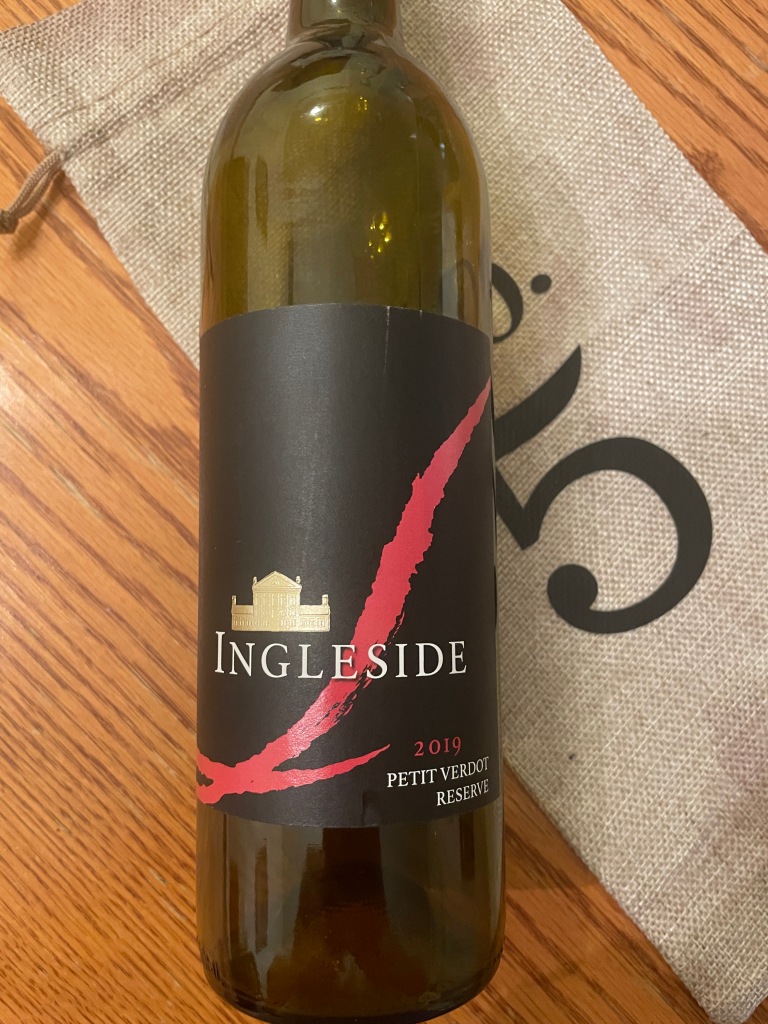
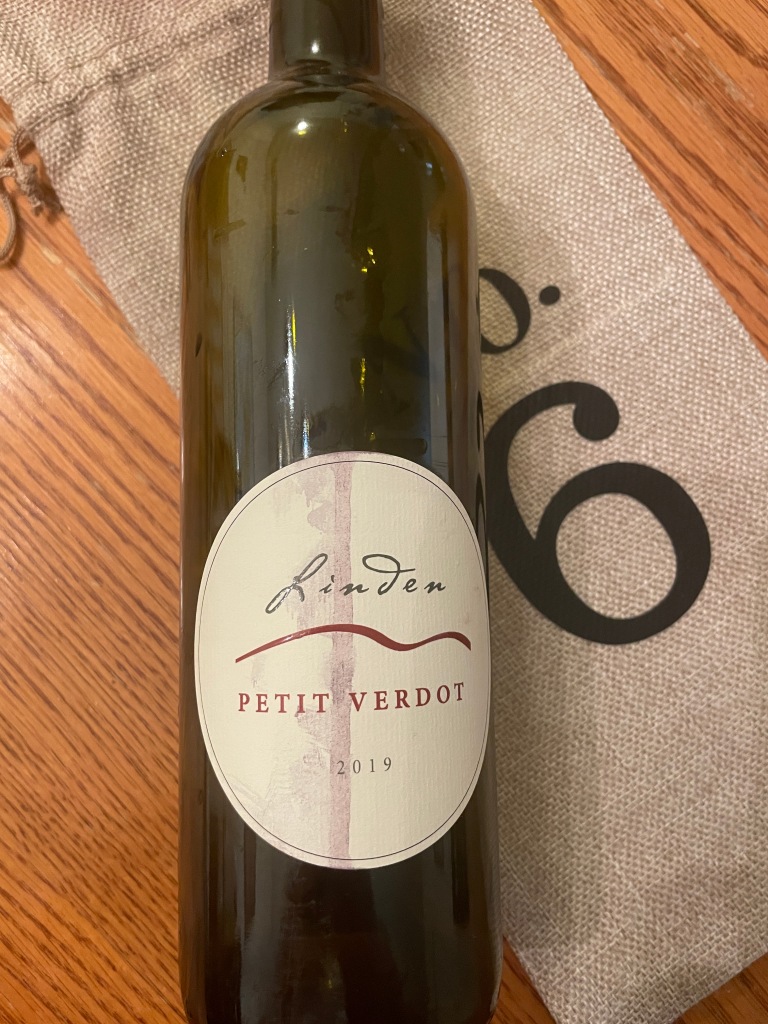
What I liked about this round is how different these bottles were from the previous one. It was a real demonstration of the diversity of Petit Verdot. Even the coloration was different.
#4 and #5 quickly became the favorites. Once it opened up we liked #6 more, but it was in a tough group.
This round also showed me how difficult it would be to do a ‘wild card’ advancement, because guests kept talking about how much they loved #5 (we had the same issue with #9). I couldn’t advance “all” the great runner-ups, so I went with what we had.
Bottle #4 Wisdom Oak Winery: Most fruit-forward and acidic of the group. I found notes of tobacco and earthy, backed by some bright red fruit.
Other notes included “jammy chocolate” (one of my favorite descriptors of the day), black fruit and cherry (with hints of raspberry), hint of spice on the palate. “Smokey cedar”, with grippy tannin.
Bottle #5 Ingleside Vineyards: Lots of notes here!
I thought the earthy nose really stood out. Bright; notes of red fruit, although it tended to have more tertiary flavors. Someone mentioned dark chocolate, chewy, ‘plush’. Another said notes of bell pepper, cardamom, even cinnamon stick.
Bottle #6 Linden Vineyards: Violet or tobacco on the nose. Notes of dark chocolate, mushroom, forest floor. Another said they found a plum note.
It was also soft and the least acidic of the group (perhaps because it was made in steel, not oak).
Votes:
- Alex: 5/4/6. Liked the tobacco and tannin profile of #5 (Ingleside)
- Ashley: 5/4/6. Liked the long finish of #5, beautiful complexity on the nose and palate. Noted the nose and palate didn’t line up but that was a good thing.
- Brandon: 4/5/6. Liked the fruitiness an tartness
- Emily: 4/5/6. Thought #5 was ‘sultry’ but chose #4 (Wisdom Oak) for the fruit profile.
- Frank: 4/5/6. Liked the layers of flavors on #4.
- Isabel: 4/5/6
- Matt: 4/5/6; liked the fruit on this one.
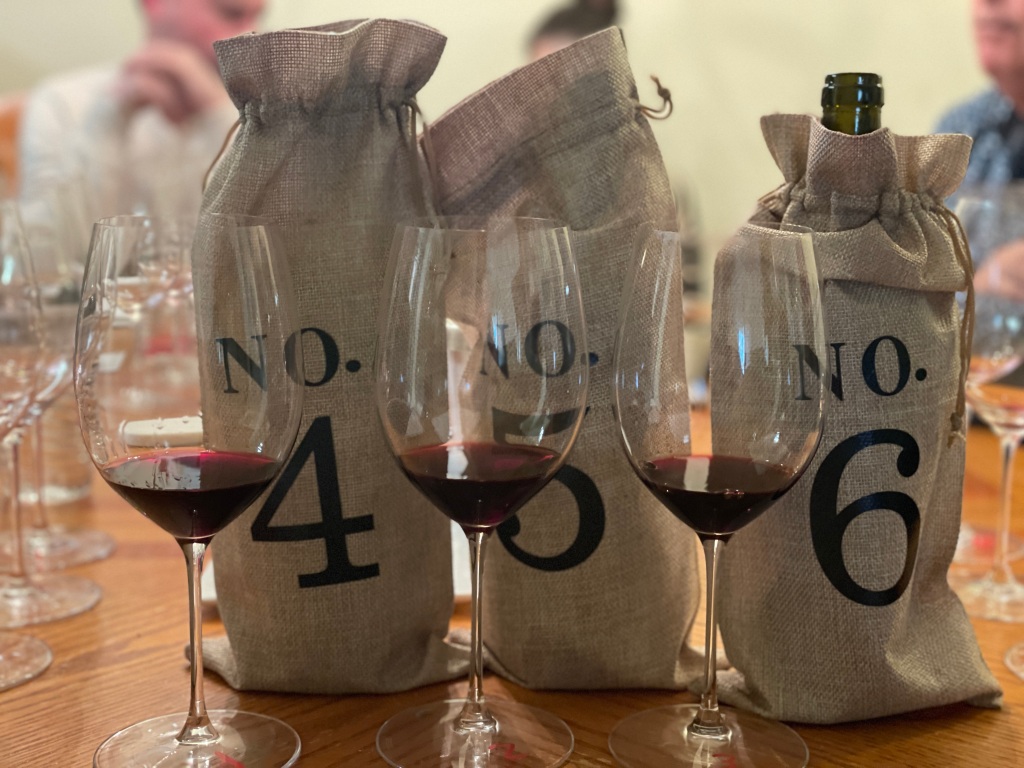
Round 1 / Flight #3:
- Bottle #7: Cave Ridge Vineyards (Round winner)
- Bottle #8: Hark Vineyards
- Bottle #9: Pollack Vineyards

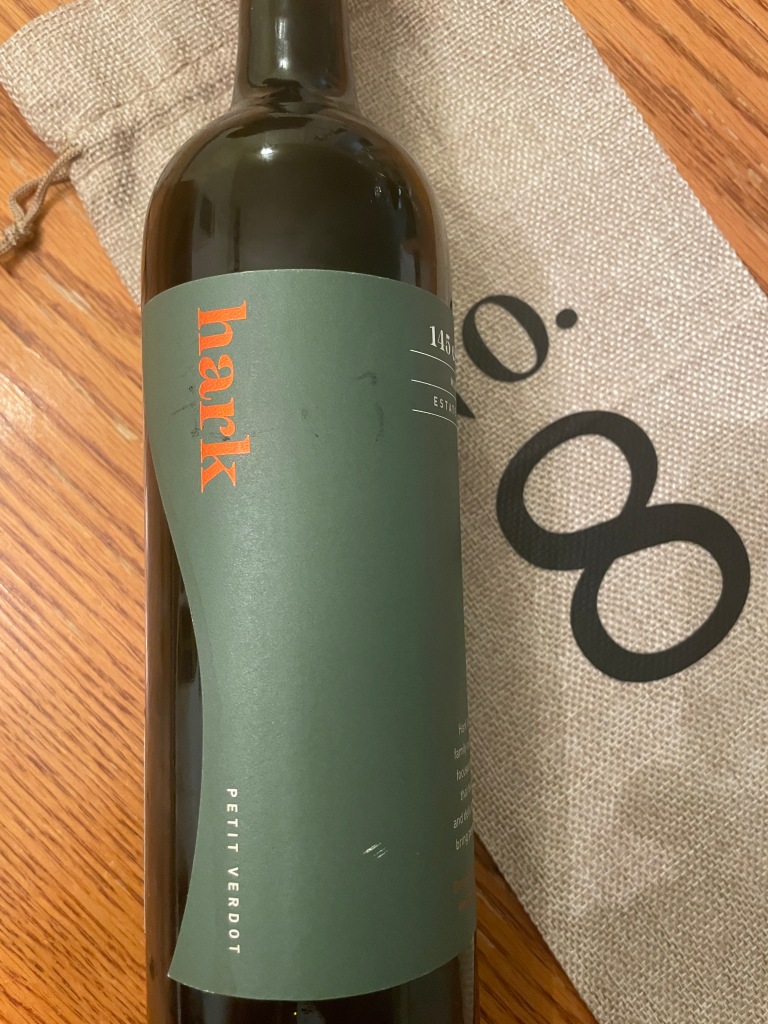

This was our ‘classic’ round, at least on the nose. As our palates got tired we had fewer notes, but that doesn’t mean we enjoyed the wines less.
Bottle #7 Cave Ridge Vineyards: We felt it was one of the higher alcohol wines of the grouping (unfortunately I couldn’t find the alcohol level on the bottle).
The nose was savory. Not an especially fruit-forward wine (except maybe cooked fruit); it was more about the body. Someone mentioned it has a ‘meaty’ note on the nose. Descriptors of musty and savory kept being thrown out. Another said it had a chili note.
Bottle #8 Hark Vineyards: For several participants, “vegetal’ was the key descriptor on the palate. Maybe notes of asparagus? Someone mentioned they found a pine tree/evergreen note. The vegetal characteristics diminished the next day, when I finished it up.
Another participant found notes of blueberry on the nose, maybe licorice.
Bottle #9 Pollack Vineyards: Alcohol on the nose but an overall complex wine. Notes of red cherry or dark chocolate were mentioned. Smooth; balanced.
Votes:
- Alex: 9/7/8. Thought #9 (Pollack) was smooth and drinkable
- Ashley: 7/9/8. 7 (Cave Ridge) and 9 were almost tied, but thought #7 had more body
- Brandon: 7/9/8. Thought it was balanced and liked the funky notes to it.
- Emily: 7/9/8. Thought #7 was ‘very Virginia’
- Frank: 9/8/7. Favored the red fruit and thought it was less oaky.
- Isabel: 9/7/8. Thought #7 was very drinkable and had more body.
- Matt: 7/9/8. Was really torn between #7 and #9.
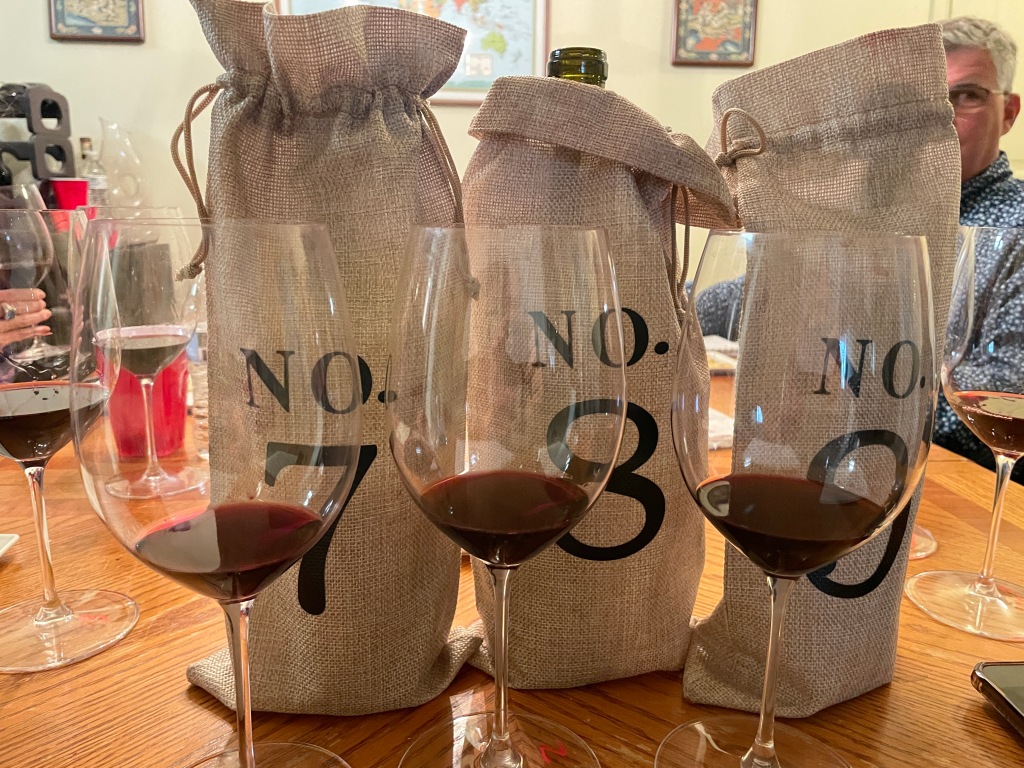
Finalist Round:
- Bottle #2: Chateau MerrillAnne (Event Winner)
- Bottle #4: Wisdom Oak Winery (Runner Up)
- Bottle #7: Cave Ridge
We took a food break after the first 3 rounds before moving to the ‘finalist’. I didn’t do a round-robin of tasting notes. People spent some time with this trio then went to judging.
As we had so many great wines that could have advanced, I took the extra step of asking people what their favorite wine of the entire event was. That was enlightening; it showed how many of people’s personal favorites didn’t make it to the last round.
In the end Chateau MerrillAnne’s 2019 Petit Verdot was the favorite of the day. I reached out to them and learned this bottle was 100% PV, saw 16 months in oak, 33% of which was new French oak w/ medium+ char. Made by Michael Shaps using fruit from Honah Lee vineyard.
Perhaps best of all – the winner is still for sale at the winery (at least as of January 2024)
I also insisted they save me a bottle for when I visit next (hopefully soon).
- Ashley: 2/4/7. Liked the heat and complexity of #2 (MerrillAnne) but still thought #5 (Ingleside) was her favorite of the day.
- Alex: 2/4/7. Thought #2 was the most complex and had the greatest depth of flavor. But ‘favorite’ of the day was #2 or #5.
- Brandon: 2/4/7. Thought #2 was ‘sexy’, and thought it was his overall favorite of the day.
- Emily: 7/4/2. Thought #1 (DuCard) and #7 (Cave Ridge) were great.
- Frank: 2/4/7. Thought #2 had complexity and layers of flavor, but still thought #9 was the best of the day.
- Isabel: 4/2/7. Still thought the ‘slutty’ #9 (Pollack; and yes, that was the term) was her favorite. But thought #4 (Wisdom Oak) had character.
- Matt: 2/7/4. I still think my favorites were an almost even toss-up between #1 and #2. I hogged the DuCard towards the end of the night, when we were socializing.
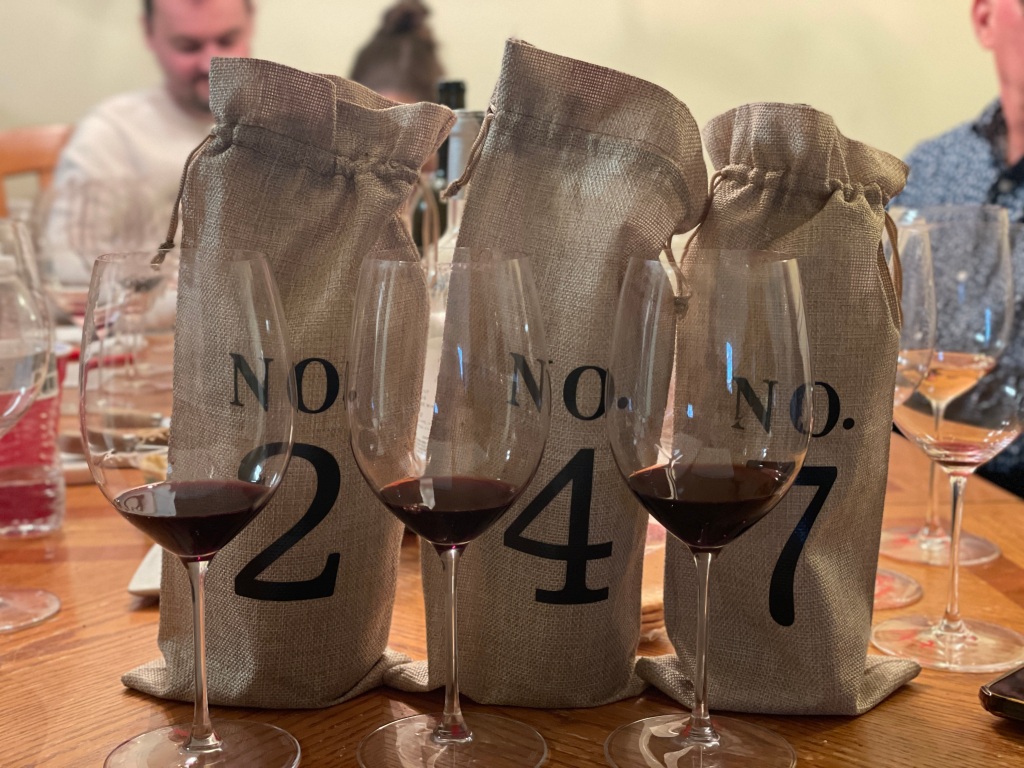
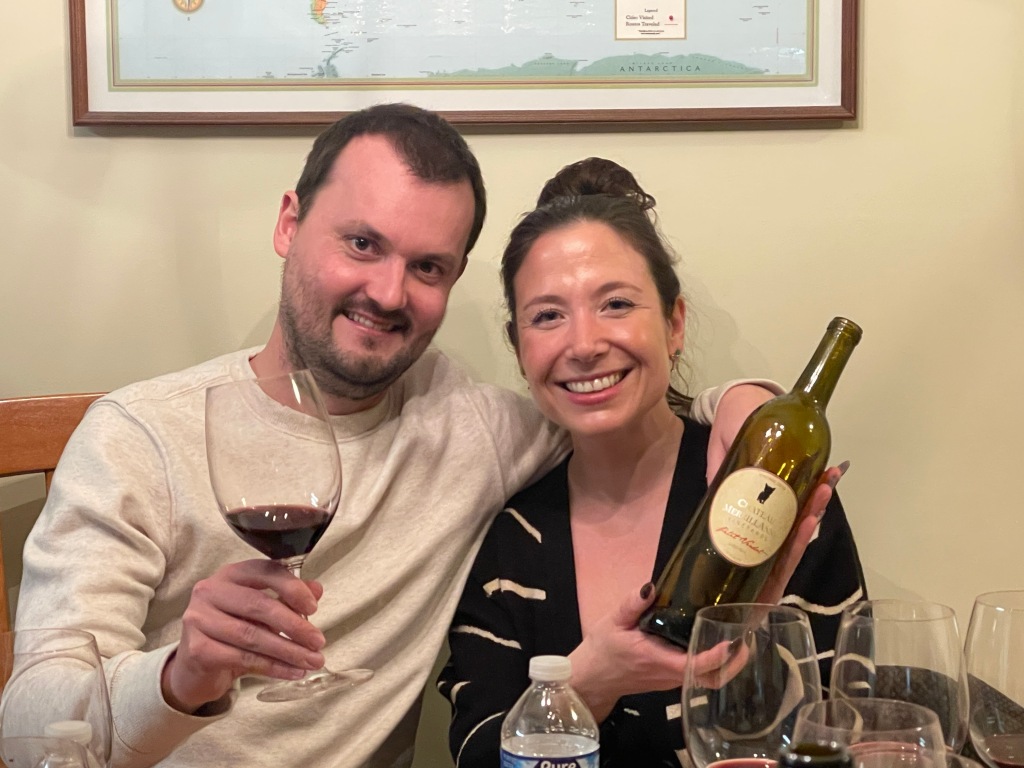
Lessons Learned
I kept emphasizing that I don’t pretend that my events identify the ‘best’ wine; only the consensus favorite of a large group. On another day or with a different group, I’m certain the results would have been different.
That statement is always true but seemed especially true this time. I think my format of 3 flights of 3 followed by a ‘finalist’ round is fair but it also leaves out some excellent bottles, as not all rounds showcase equally good wines (they are bagged blind, after all). I sometimes try to even that out by advancing the ‘favorite runner up’ as a ‘wild card’…but #1, #5, and #9 were so liked, ANY of them could have been a wild card.
If there’s a ‘lesson learned’, it was that Petit Vedot has range. We had 9 wines and all of them were different. While #3/#6/#8 didn’t get as much attention as the others, that’s not to say we didn’t enjoy them as well.

How do you keep the wine identities hidden from yourself? This is a really interesting tasting, as 19 was such a hit year. Love the same varietal horizontal format though- well done!
LikeLike
Pingback: The Petit Verdot Championship Round | Wine Trails and Wanderlust